steering wheel Hyundai Elantra 2006 Owner's Manual
[x] Cancel search | Manufacturer: HYUNDAI, Model Year: 2006, Model line: Elantra, Model: Hyundai Elantra 2006Pages: 277, PDF Size: 10.18 MB
Page 51 of 277
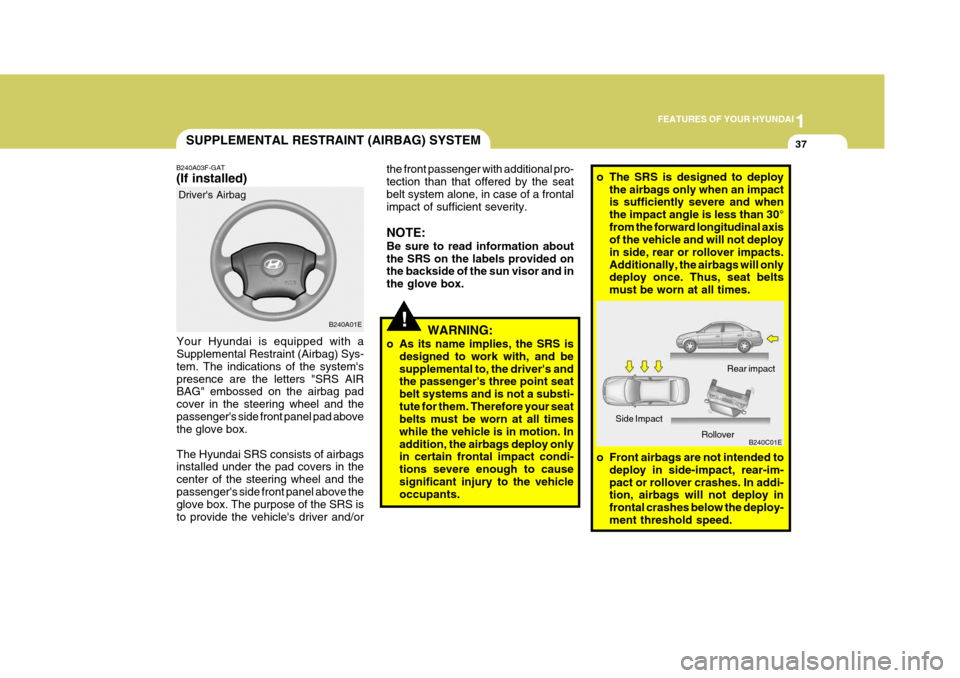
1
FEATURES OF YOUR HYUNDAI
37SUPPLEMENTAL RESTRAINT (AIRBAG) SYSTEM
B240A03F-GAT (If installed)
Your Hyundai is equipped with a Supplemental Restraint (Airbag) Sys- tem. The indications of the system'spresence are the letters "SRS AIR BAG" embossed on the airbag pad cover in the steering wheel and thepassenger's side front panel pad above the glove box. The Hyundai SRS consists of airbags installed under the pad covers in the center of the steering wheel and thepassenger's side front panel above the glove box. The purpose of the SRS is to provide the vehicle's driver and/or B240A01E
Driver's Airbag
!
the front passenger with additional pro- tection than that offered by the seatbelt system alone, in case of a frontal impact of sufficient severity. NOTE: Be sure to read information about the SRS on the labels provided on the backside of the sun visor and in the glove box.
WARNING:
o As its name implies, the SRS is designed to work with, and besupplemental to, the driver's and the passenger's three point seat belt systems and is not a substi-tute for them. Therefore your seat belts must be worn at all times while the vehicle is in motion. Inaddition, the airbags deploy only in certain frontal impact condi- tions severe enough to causesignificant injury to the vehicle occupants.o The SRS is designed to deploythe airbags only when an impact is sufficiently severe and when the impact angle is less than 30°from the forward longitudinal axis of the vehicle and will not deploy in side, rear or rollover impacts.Additionally, the airbags will only deploy once. Thus, seat belts must be worn at all times.
B240C01E
Rear impact
Side Impact Rollover
o Front airbags are not intended to deploy in side-impact, rear-im-pact or rollover crashes. In addi- tion, airbags will not deploy in frontal crashes below the deploy-ment threshold speed.
Page 52 of 277
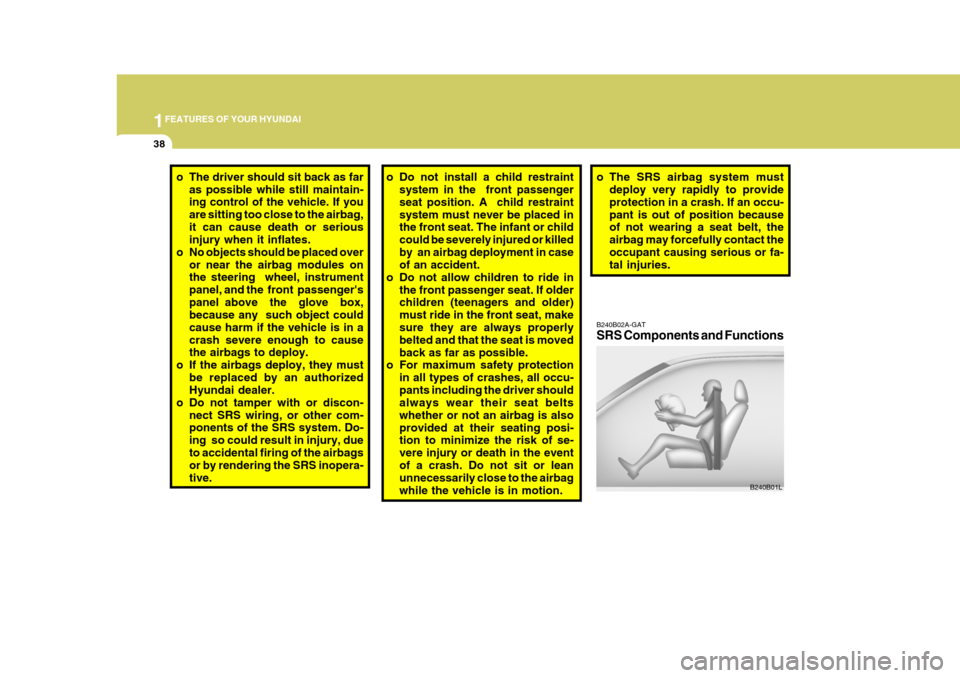
1FEATURES OF YOUR HYUNDAI
38
o The SRS airbag system must
deploy very rapidly to provide protection in a crash. If an occu-pant is out of position because of not wearing a seat belt, the airbag may forcefully contact theoccupant causing serious or fa- tal injuries.
B240B02A-GAT SRS Components and Functions
B240B01L
o The driver should sit back as faras possible while still maintain- ing control of the vehicle. If you are sitting too close to the airbag,it can cause death or serious injury when it inflates.
o No objects should be placed over or near the airbag modules onthe steering wheel, instrument panel, and the front passenger'spanel above the glove box, because any such object could cause harm if the vehicle is in acrash severe enough to cause the airbags to deploy.
o If the airbags deploy, they must be replaced by an authorizedHyundai dealer.
o Do not tamper with or discon- nect SRS wiring, or other com-ponents of the SRS system. Do- ing so could result in injury, dueto accidental firing of the airbags or by rendering the SRS inopera- tive. o Do not install a child restraint
system in the front passengerseat position. A child restraintsystem must never be placed in the front seat. The infant or child could be severely injured or killedby an airbag deployment in case of an accident.
o Do not allow children to ride in the front passenger seat. If olderchildren (teenagers and older) must ride in the front seat, makesure they are always properly belted and that the seat is moved back as far as possible.
o For maximum safety protection
in all types of crashes, all occu-pants including the driver should always wear their seat belts whether or not an airbag is alsoprovided at their seating posi- tion to minimize the risk of se- vere injury or death in the eventof a crash. Do not sit or lean unnecessarily close to the airbag while the vehicle is in motion.
Page 53 of 277
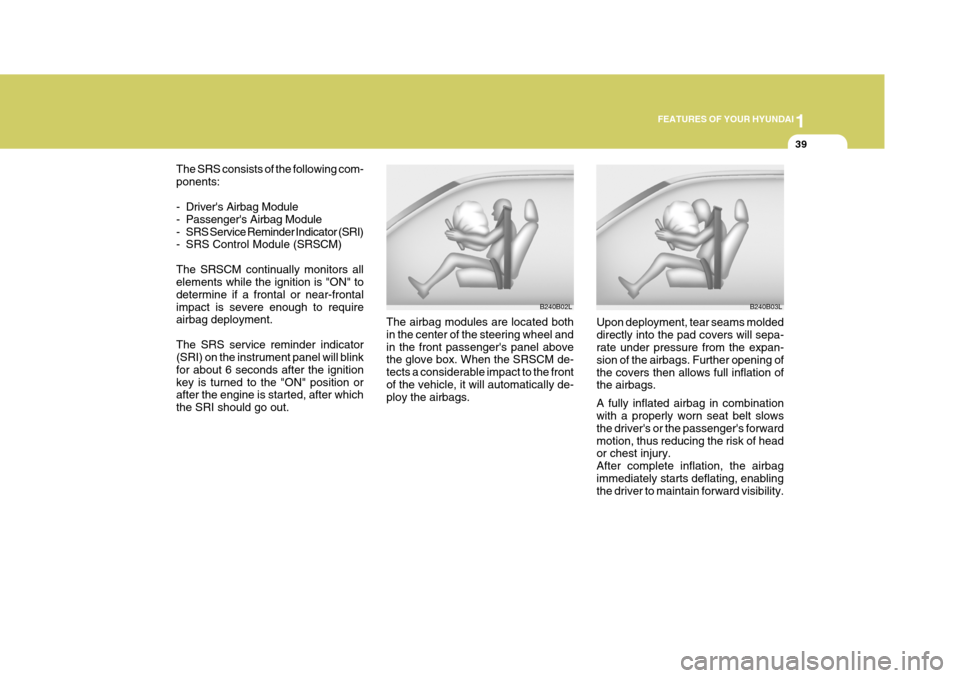
1
FEATURES OF YOUR HYUNDAI
39
B240B03L
The airbag modules are located both in the center of the steering wheel and in the front passenger's panel above the glove box. When the SRSCM de- tects a considerable impact to the frontof the vehicle, it will automatically de- ploy the airbags. Upon deployment, tear seams molded directly into the pad covers will sepa- rate under pressure from the expan- sion of the airbags. Further opening ofthe covers then allows full inflation of the airbags. A fully inflated airbag in combination with a properly worn seat belt slows the driver's or the passenger's forwardmotion, thus reducing the risk of head or chest injury. After complete inflation, the airbagimmediately starts deflating, enabling the driver to maintain forward visibility.B240B02L
The SRS consists of the following com- ponents:
- Driver's Airbag Module
- Passenger's Airbag Module
- SRS Service Reminder Indicator (SRI)
- SRS Control Module (SRSCM) The SRSCM continually monitors all elements while the ignition is "ON" to determine if a frontal or near-frontalimpact is severe enough to require airbag deployment. The SRS service reminder indicator (SRI) on the instrument panel will blink for about 6 seconds after the ignitionkey is turned to the "ON" position or after the engine is started, after which the SRI should go out.
Page 56 of 277
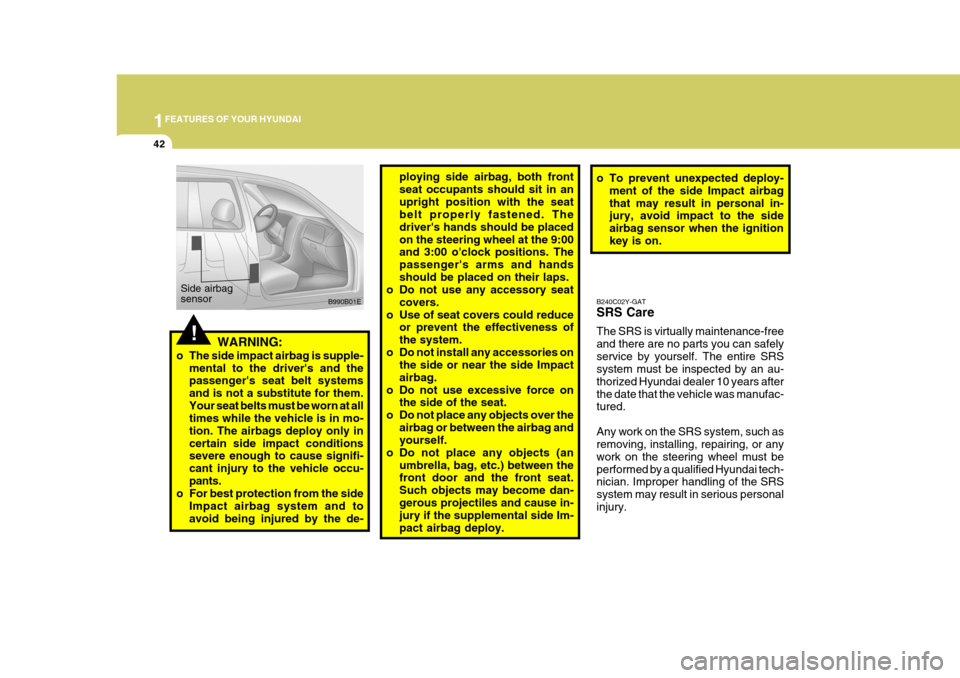
1FEATURES OF YOUR HYUNDAI
42
B240C02Y-GAT SRS Care The SRS is virtually maintenance-free and there are no parts you can safelyservice by yourself. The entire SRS system must be inspected by an au- thorized Hyundai dealer 10 years afterthe date that the vehicle was manufac- tured. Any work on the SRS system, such as removing, installing, repairing, or any work on the steering wheel must beperformed by a qualified Hyundai tech- nician. Improper handling of the SRS system may result in serious personalinjury.
!WARNING:
o The side impact airbag is supple- mental to the driver's and the passenger's seat belt systems and is not a substitute for them.Your seat belts must be worn at all times while the vehicle is in mo- tion. The airbags deploy only incertain side impact conditions severe enough to cause signifi- cant injury to the vehicle occu-pants.
o For best protection from the side
Impact airbag system and toavoid being injured by the de- B990B01E
Side airbag sensor
ploying side airbag, both front seat occupants should sit in anupright position with the seat belt properly fastened. The driver's hands should be placedon the steering wheel at the 9:00 and 3:00 o'clock positions. The passenger's arms and handsshould be placed on their laps.
o Do not use any accessory seat
covers.
o Use of seat covers could reduce or prevent the effectiveness ofthe system.
o Do not install any accessories on the side or near the side Impactairbag.
o Do not use excessive force on the side of the seat.
o Do not place any objects over the airbag or between the airbag and yourself.
o Do not place any objects (an umbrella, bag, etc.) between thefront door and the front seat. Such objects may become dan-gerous projectiles and cause in- jury if the supplemental side Im- pact airbag deploy. o To prevent unexpected deploy-
ment of the side Impact airbagthat may result in personal in- jury, avoid impact to the side airbag sensor when the ignitionkey is on.
Page 57 of 277
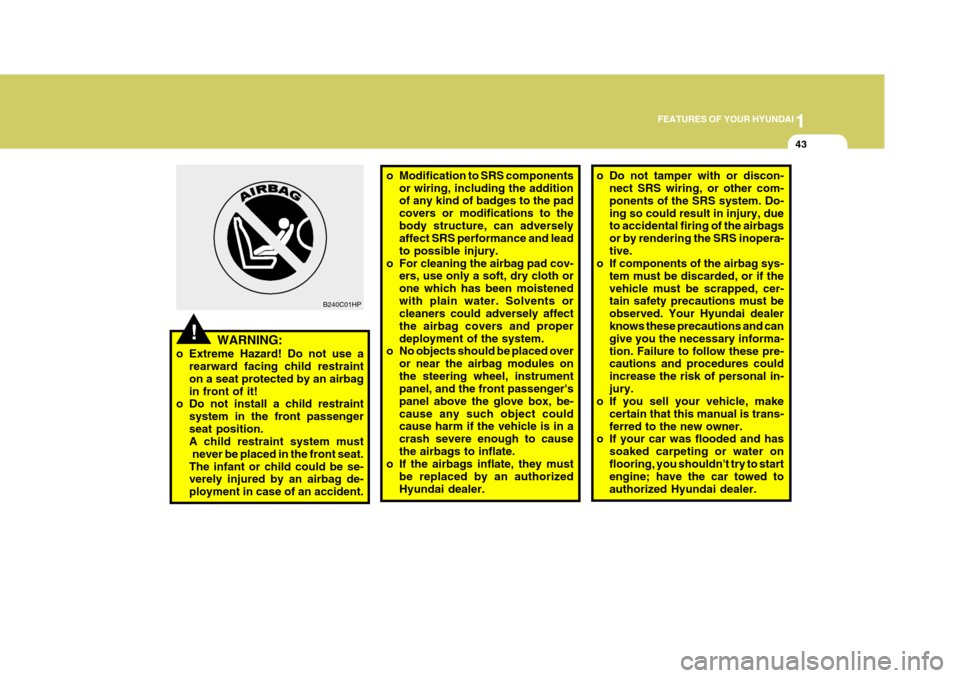
1
FEATURES OF YOUR HYUNDAI
43
!
o Modification to SRS components
or wiring, including the addition of any kind of badges to the pad covers or modifications to thebody structure, can adversely affect SRS performance and lead to possible injury.
o For cleaning the airbag pad cov- ers, use only a soft, dry cloth orone which has been moistenedwith plain water. Solvents or cleaners could adversely affect the airbag covers and properdeployment of the system.
o No objects should be placed over
or near the airbag modules onthe steering wheel, instrument panel, and the front passenger's panel above the glove box, be-cause any such object could cause harm if the vehicle is in a crash severe enough to causethe airbags to inflate.
o If the airbags inflate, they must
be replaced by an authorizedHyundai dealer.
B240C01HP
WARNING:
o Extreme Hazard! Do not use a rearward facing child restrainton a seat protected by an airbagin front of it!
o Do not install a child restraint
system in the front passengerseat position. A child restraint system must
never be placed in the front seat.The infant or child could be se- verely injured by an airbag de- ployment in case of an accident.o Do not tamper with or discon-nect SRS wiring, or other com- ponents of the SRS system. Do-ing so could result in injury, due to accidental firing of the airbags or by rendering the SRS inopera-tive.
o If components of the airbag sys-
tem must be discarded, or if thevehicle must be scrapped, cer- tain safety precautions must be observed. Your Hyundai dealerknows these precautions and can give you the necessary informa- tion. Failure to follow these pre- cautions and procedures could increase the risk of personal in-jury.
o If you sell your vehicle, make
certain that this manual is trans-ferred to the new owner.
o If your car was flooded and has
soaked carpeting or water onflooring, you shouldn't try to start engine; have the car towed to authorized Hyundai dealer.
Page 70 of 277

1FEATURES OF YOUR HYUNDAI
56TRIP COMPUTER
B400B03E-GAT (If installed) The trip computer is a microcomputer- controlled driver information gauge that displays information related to driving, such as a tripmeter, average fuel con-sumption and distance to empty on the LCD. Trip Computer Switch
o The trip computer switch is used to
zero the multi-functional display mode.
o Pushing in the trip computer switch behind the left side of the steeringwheel changes the display as fol-lows; 1. Tripmeter
Tripmeter
TRIPMETER
AVERAGE FUEL CONSUMPTION DISTANCE TO EMPTY
HXDFL371-1
HXDFL230A
B310A01S-GAT ODOMETER The odometer records the total driving distance in kilometers or miles, and is useful for keeping a record for mainte-nance intervals. NOTE: Any alteration of the odometer may void your warranty coverage.
With Trip Computer
HXDFL230 o This mode indicates the total dis-tance travelled since the lasttripmeter reset. Total distance is also reset to zero if the battery is disconnected. Odometer
Odometer
Page 97 of 277
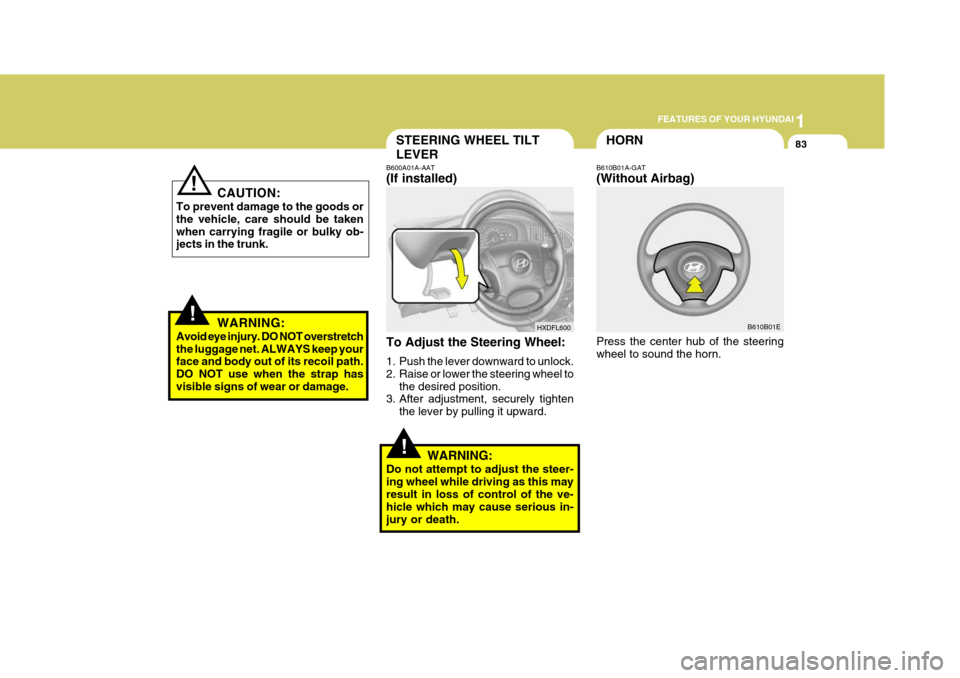
1
FEATURES OF YOUR HYUNDAI
83
!
B600A01A-AAT (If installed) B610B01A-GAT(Without Airbag)
To Adjust the Steering Wheel:
1. Push the lever downward to unlock.
2. Raise or lower the steering wheel to the desired position.
3. After adjustment, securely tighten
the lever by pulling it upward.
WARNING:
Do not attempt to adjust the steer-ing wheel while driving as this may result in loss of control of the ve- hicle which may cause serious in-jury or death. Press the center hub of the steering wheel to sound the horn.
B610B01E
HXDFL600
STEERING WHEEL TILT LEVER
HORN
!
!
CAUTION:
To prevent damage to the goods or the vehicle, care should be takenwhen carrying fragile or bulky ob- jects in the trunk.
WARNING:
Avoid eye injury. DO NOT overstretch the luggage net. ALWAYS keep your face and body out of its recoil path. DO NOT use when the strap hasvisible signs of wear or damage.
Page 98 of 277
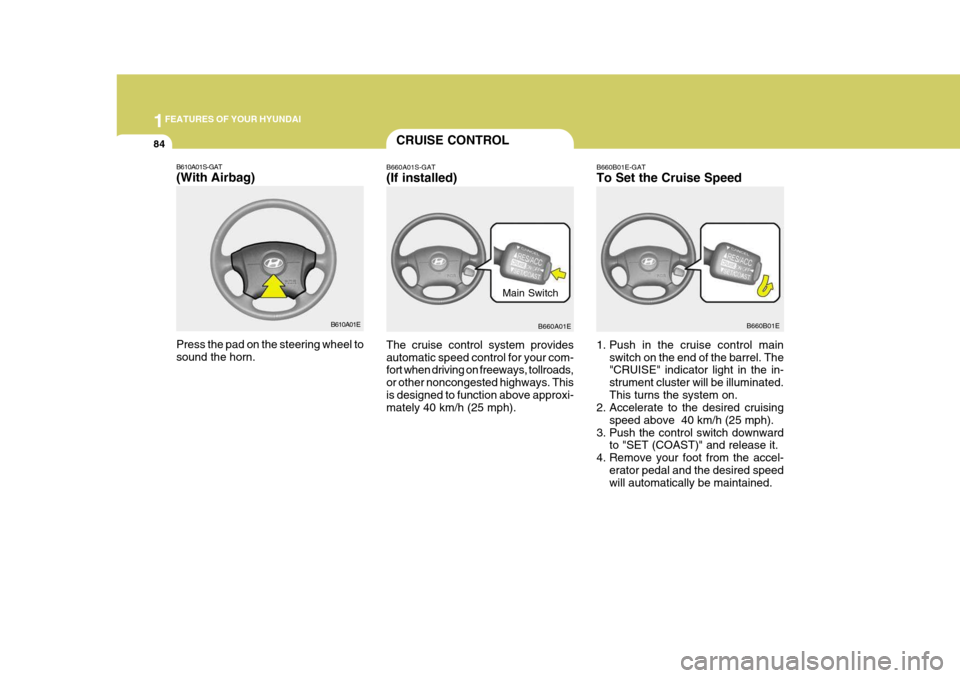
1FEATURES OF YOUR HYUNDAI
84CRUISE CONTROL
B660A01S-GAT (If installed) B660B01E-GATTo Set the Cruise Speed
The cruise control system provides automatic speed control for your com- fort when driving on freeways, tollroads, or other noncongested highways. Thisis designed to function above approxi- mately 40 km/h (25 mph). 1. Push in the cruise control main
switch on the end of the barrel. The"CRUISE" indicator light in the in- strument cluster will be illuminated.This turns the system on.
2. Accelerate to the desired cruising
speed above 40 km/h (25 mph).
3. Push the control switch downward to "SET (COAST)" and release it.
4. Remove your foot from the accel- erator pedal and the desired speed will automatically be maintained.
B660A01E
B660B01E
Main Switch
B610A01S-GAT (With Airbag) Press the pad on the steering wheel to sound the horn. B610A01E
Page 99 of 277
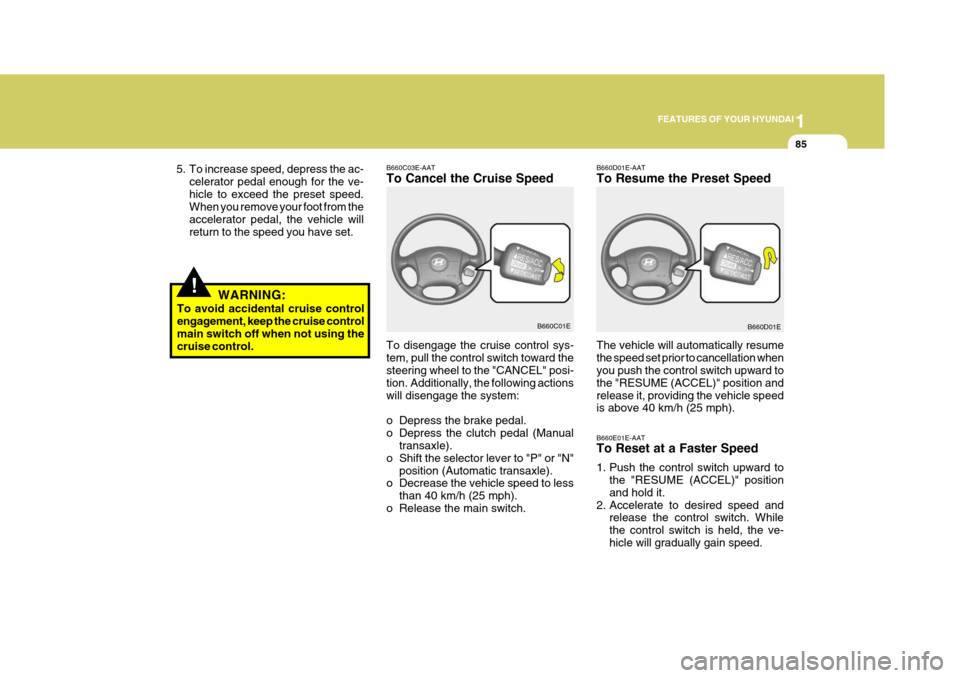
1
FEATURES OF YOUR HYUNDAI
85
!
B660C03E-AAT To Cancel the Cruise Speed B660D01E-AATTo Resume the Preset Speed
To disengage the cruise control sys- tem, pull the control switch toward the steering wheel to the "CANCEL" posi-
tion. Additionally, the following actionswill disengage the system:
o Depress the brake pedal.
o Depress the clutch pedal (Manual transaxle).
o Shift the selector lever to "P" or "N" position (Automatic transaxle).
o Decrease the vehicle speed to less
than 40 km/h (25 mph).
o Release the main switch. The vehicle will automatically resumethe speed set prior to cancellation when you push the control switch upward to the "RESUME (ACCEL)" position andrelease it, providing the vehicle speed is above 40 km/h (25 mph).
B660C01E
B660D01E
5. To increase speed, depress the ac-
celerator pedal enough for the ve- hicle to exceed the preset speed. When you remove your foot from the accelerator pedal, the vehicle willreturn to the speed you have set.
WARNING:
To avoid accidental cruise control engagement, keep the cruise control main switch off when not using thecruise control.
B660E01E-AAT To Reset at a Faster Speed
1. Push the control switch upward tothe "RESUME (ACCEL)" position and hold it.
2. Accelerate to desired speed and release the control switch. Whilethe control switch is held, the ve-hicle will gradually gain speed.
Page 157 of 277
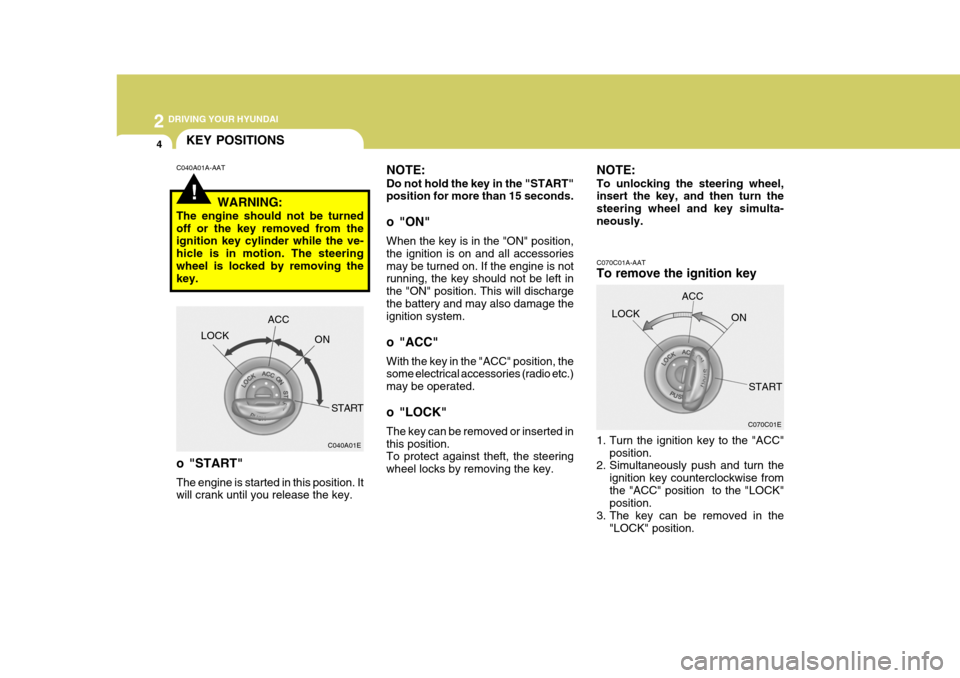
2 DRIVING YOUR HYUNDAI
4
!
KEY POSITIONS
C070C01E
C070C01A-AAT To remove the ignition key
1. Turn the ignition key to the "ACC"
position.
2. Simultaneously push and turn the
ignition key counterclockwise from the "ACC" position to the "LOCK" position.
3. The key can be removed in the
"LOCK" position.LOCK
ACC
ON
START
NOTE: Do not hold the key in the "START" position for more than 15 seconds.
o "ON" When the key is in the "ON" position, the ignition is on and all accessoriesmay be turned on. If the engine is not running, the key should not be left in the "ON" position. This will dischargethe battery and may also damage the ignition system.
o "ACC" With the key in the "ACC" position, the some electrical accessories (radio etc.) may be operated.
o "LOCK" The key can be removed or inserted in this position. To protect against theft, the steering wheel locks by removing the key.
C040A01A-AAT
C040A01E
LOCK
ACC
ON
START
WARNING:
The engine should not be turnedoff or the key removed from the ignition key cylinder while the ve- hicle is in motion. The steeringwheel is locked by removing the key.
o "START" The engine is started in this position. It will crank until you release the key. NOTE: To unlocking the steering wheel, insert the key, and then turn the steering wheel and key simulta-neously.